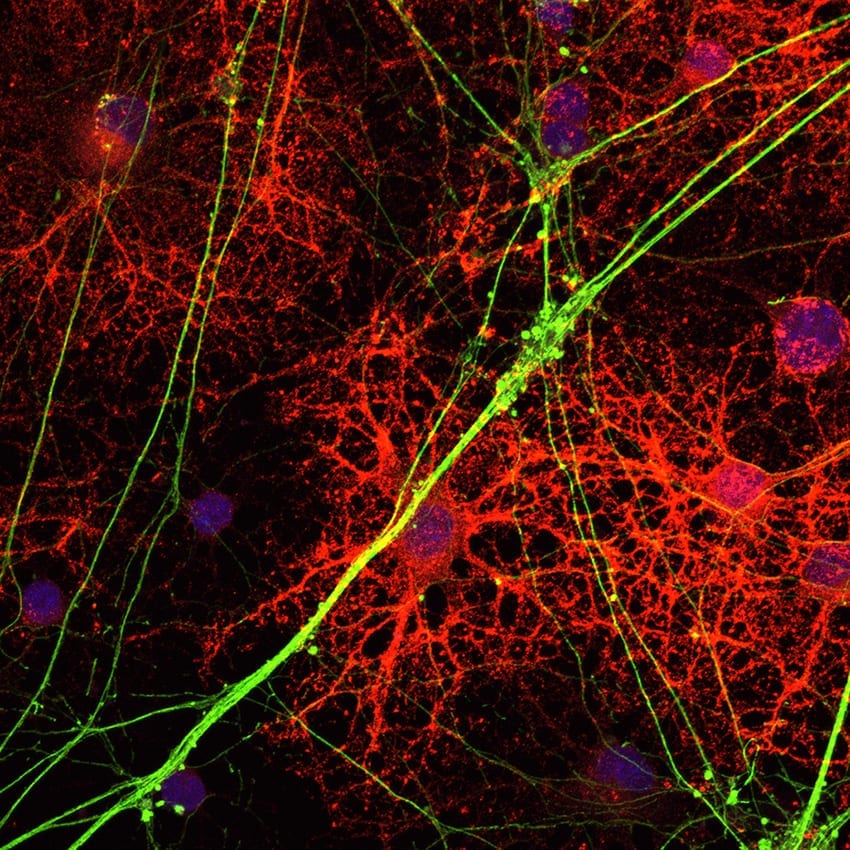
Findings Point to Potential New Use of an Existing Drug
Scientists at The Scripps Research Institute (TSRI) have identified a set of compounds that may be used to treat multiple sclerosis (MS) in a new way. Unlike existing MS therapies that suppress the immune system, the compounds boost a population of progenitor cells that can in turn repair MS-damaged nerve fibers.
One of the newly identified compounds, a Parkinson’s disease drug called benztropine, was highly effective in treating a standard model of MS in mice, both alone and in combination with existing MS therapies.
“We’re excited about these results, and are now considering how to design an initial clinical trial,” said Luke L. Lairson, an assistant professor of chemistry at TSRI and a senior author of the study, which is reported online in Nature on October 9, 2013.
Lairson cautioned that benztropine is a drug with dose-related adverse side effects, and has yet to be proven effective at a safe dose in human MS patients. “People shouldn’t start using it off-label for MS,” he said.
A New Approach
An autoimmune disease of the brain and spinal cord, MS currently affects more than half a million people in North America and Europe, and more than two million worldwide. Its precise triggers are unknown, but certain infections and a lack of vitamin D are thought to be risk factors. The disease is much more common among those of Northern European heritage, and occurs about twice as often in women as in men.
In MS, immune cells known as T cells infiltrate the upper spinal cord and brain, causing inflammation and ultimately the loss of an insulating coating called myelin on some nerve fibers. As nerve fibers lose this myelin coating, they lose their ability to transmit signals efficiently, and in time may begin to degenerate. The resulting symptoms, which commonly occur in a stop-start, “relapsing-remitting” pattern, may include limb weakness, numbness and tingling, fatigue, vision problems, slurred speech, memory difficulties and depression, among other problems.
Current therapies, such as interferon beta, aim to suppress the immune attack that de-myelinates nerve fibers. But they are only partially effective and are apt to have significant adverse side effects.
Scientists at The Scripps Research Institute (TSRI) have identified a set of compounds that may be used to treat multiple sclerosis (MS) in a new way. Unlike existing MS therapies that suppress the immune system, the compounds boost a population of progenitor cells that can in turn repair MS-damaged nerve fibers.
One of the newly identified compounds, a Parkinson’s disease drug called benztropine, was highly effective in treating a standard model of MS in mice, both alone and in combination with existing MS therapies.
“We’re excited about these results, and are now considering how to design an initial clinical trial,” said Luke L. Lairson, an assistant professor of chemistry at TSRI and a senior author of the study, which is reported online in Nature on October 9, 2013.
Lairson cautioned that benztropine is a drug with dose-related adverse side effects, and has yet to be proven effective at a safe dose in human MS patients. “People shouldn’t start using it off-label for MS,” he said.
A New Approach
An autoimmune disease of the brain and spinal cord, MS currently affects more than half a million people in North America and Europe, and more than two million worldwide. Its precise triggers are unknown, but certain infections and a lack of vitamin D are thought to be risk factors. The disease is much more common among those of Northern European heritage, and occurs about twice as often in women as in men.
In MS, immune cells known as T cells infiltrate the upper spinal cord and brain, causing inflammation and ultimately the loss of an insulating coating called myelin on some nerve fibers. As nerve fibers lose this myelin coating, they lose their ability to transmit signals efficiently, and in time may begin to degenerate. The resulting symptoms, which commonly occur in a stop-start, “relapsing-remitting” pattern, may include limb weakness, numbness and tingling, fatigue, vision problems, slurred speech, memory difficulties and depression, among other problems.
Current therapies, such as interferon beta, aim to suppress the immune attack that de-myelinates nerve fibers. But they are only partially effective and are apt to have significant adverse side effects.
Go deeper with Bing News on:
Multiple Sclerosis
- Office Support Volunteers Needed for National Multiple Sclerosis Society
Texas MS150, all our supplies and items are slowly making their way back to our office (1050 N. Post Oak Rd. Ste 240 Houston, TX 77055) This ...
- Multiple sclerosis patients find hope in ‘liquid gold’
The world has over 1.8 million people with multiple sclerosis in the world, according to the World Health Organization in 2023. The Mayo Clinic says it attacks a person’s nervous system, causing ...
- Drinking Tiny Gold Crystals May Help With MS Vision Problems
People with multiple sclerosis who drank a medicine containing gold nanocrystals daily for nearly 3 years got better vision, according to study results presented at a neurology conference this month.
- Finley siblings share their fight against Multiple Sclerosis, encourages people to get checked
According to the National Multiple Sclerosis Society, almost one million Americans live with Multiple Sclerosis (MS), an auto-immune condition that affects the central nervous system. According to ...
- ‘Liquid gold’ could bring new hope to multiple sclerosis patients, study suggests: ‘Profound benefit’
An experimental medication called CNM-Au8 — a drinkable liquid with gold nanocrystals — has shown promising results in clinical trials for improving MS symptoms. Doctors and researchers weighed in.
Go deeper with Google Headlines on:
Multiple Sclerosis
[google_news title=”” keyword=”Multiple Sclerosis” num_posts=”5″ blurb_length=”0″ show_thumb=”left”]
Go deeper with Bing News on:
MS
- Old Bridge MS Shelters In Place, 'Multiple Severe Injuries' In Fire At Nearby Business: Police
Firefighters, EMS and police from five towns are on the scene of a fire at a commercial building on West Greystone Road in Old Bridge on Wednesday, May 1. There was a report of an explosion at about ...
- MS Dhoni walks back silently after getting dismissed for the first time in IPL 2024
Mahendra Singh Dhoni was dismissed for the first time in IPL 2024 when he was run out on the last ball of the Chennai Super Kings innings against Punj ...
- A lifetime of abuse: State was investigating MS parents before baby’s death, records show
MDHS allowed the 4-month-old baby to remain with his parents in Gulfport despite an open investigation into child abuse against them.
- A lifetime of abuse: CPS was investigating MS parents before baby’s death, records show
MDHS allowed the 4-month-old baby to remain with his parents in Gulfport despite an open investigation into child abuse against them.
- 'Autoantibody Signature' Flags MS Years Before Symptom Onset
A unique autoantibody signature of multiple sclerosis may predict the disease years before individuals become symptomatic.
Go deeper with Google Headlines on:
MS
[google_news title=”” keyword=”MS” num_posts=”5″ blurb_length=”0″ show_thumb=”left”]










